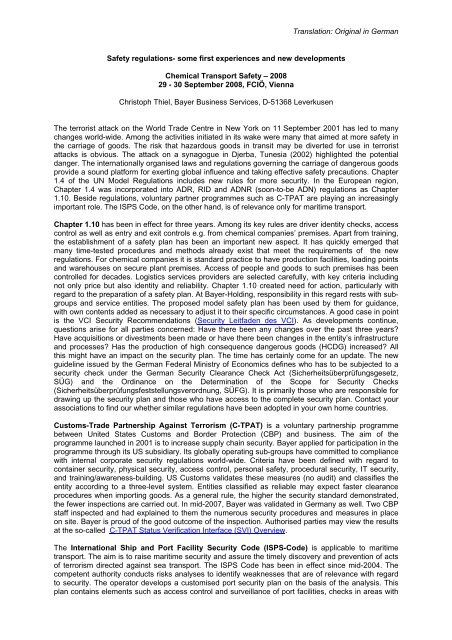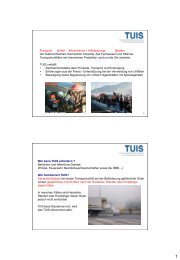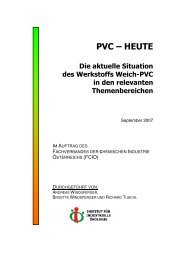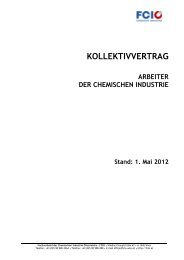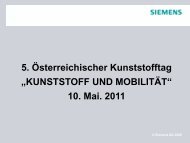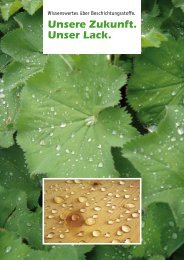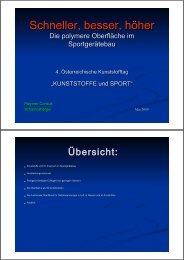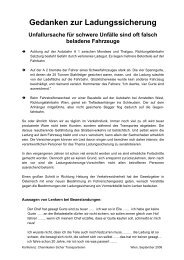Gefahrguttransporte – Sicherung & Zwischenfälle Transport of ...
Gefahrguttransporte – Sicherung & Zwischenfälle Transport of ...
Gefahrguttransporte – Sicherung & Zwischenfälle Transport of ...
Sie wollen auch ein ePaper? Erhöhen Sie die Reichweite Ihrer Titel.
YUMPU macht aus Druck-PDFs automatisch weboptimierte ePaper, die Google liebt.
Safety regulations- some first experiences and new developments<br />
Chemical <strong>Transport</strong> Safety <strong>–</strong> 2008<br />
29 - 30 September 2008, FCIÖ, Vienna<br />
Christoph Thiel, Bayer Business Services, D-51368 Leverkusen<br />
Translation: Original in German<br />
The terrorist attack on the World Trade Centre in New York on 11 September 2001 has led to many<br />
changes world-wide. Among the activities initiated in its wake were many that aimed at more safety in<br />
the carriage <strong>of</strong> goods. The risk that hazardous goods in transit may be diverted for use in terrorist<br />
attacks is obvious. The attack on a synagogue in Djerba, Tunesia (2002) highlighted the potential<br />
danger. The internationally organised laws and regulations governing the carriage <strong>of</strong> dangerous goods<br />
provide a sound platform for exerting global influence and taking effective safety precautions. Chapter<br />
1.4 <strong>of</strong> the UN Model Regulations includes new rules for more security. In the European region,<br />
Chapter 1.4 was incorporated into ADR, RID and ADNR (soon-to-be ADN) regulations as Chapter<br />
1.10. Beside regulations, voluntary partner programmes such as C-TPAT are playing an increasingly<br />
important role. The ISPS Code, on the other hand, is <strong>of</strong> relevance only for maritime transport.<br />
Chapter 1.10 has been in effect for three years. Among its key rules are driver identity checks, access<br />
control as well as entry and exit controls e.g. from chemical companies’ premises. Apart from training,<br />
the establishment <strong>of</strong> a safety plan has been an important new aspect. It has quickly emerged that<br />
many time-tested procedures and methods already exist that meet the requirements <strong>of</strong> the new<br />
regulations. For chemical companies it is standard practice to have production facilities, loading points<br />
and warehouses on secure plant premises. Access <strong>of</strong> people and goods to such premises has been<br />
controlled for decades. Logistics services providers are selected carefully, with key criteria including<br />
not only price but also identity and reliability. Chapter 1.10 created need for action, particularly with<br />
regard to the preparation <strong>of</strong> a safety plan. At Bayer-Holding, responsibility in this regard rests with subgroups<br />
and service entities. The proposed model safety plan has been used by them for guidance,<br />
with own contents added as necessary to adjust it to their specific circumstances. A good case in point<br />
is the VCI Security Recommendations (Security Leitfaden des VCI). As developments continue,<br />
questions arise for all parties concerned: Have there been any changes over the past three years?<br />
Have acquisitions or divestments been made or have there been changes in the entity’s infrastructure<br />
and processes? Has the production <strong>of</strong> high consequence dangerous goods (HCDG) increased? All<br />
this might have an impact on the security plan. The time has certainly come for an update. The new<br />
guideline issued by the German Federal Ministry <strong>of</strong> Economics defines who has to be subjected to a<br />
security check under the German Security Clearance Check Act (Sicherheitsüberprüfungsgesetz,<br />
SÜG) and the Ordinance on the Determination <strong>of</strong> the Scope for Security Checks<br />
(Sicherheitsüberprüfungsfeststellungsverordnung, SÜFG). It is primarily those who are responsible for<br />
drawing up the security plan and those who have access to the complete security plan. Contact your<br />
associations to find our whether similar regulations have been adopted in your own home countries.<br />
Customs-Trade Partnership Against Terrorism (C-TPAT) is a voluntary partnership programme<br />
between United States Customs and Border Protection (CBP) and business. The aim <strong>of</strong> the<br />
programme launched in 2001 is to increase supply chain security. Bayer applied for participation in the<br />
programme through its US subsidiary. Its globally operating sub-groups have committed to compliance<br />
with internal corporate security regulations world-wide. Criteria have been defined with regard to<br />
container security, physical security, access control, personal safety, procedural security, IT security,<br />
and training/awareness-building. US Customs validates these measures (no audit) and classifies the<br />
entity according to a three-level system. Entities classified as reliable may expect faster clearance<br />
procedures when importing goods. As a general rule, the higher the security standard demonstrated,<br />
the fewer inspections are carried out. In mid-2007, Bayer was validated in Germany as well. Two CBP<br />
staff inspected and had explained to them the numerous security procedures and measures in place<br />
on site. Bayer is proud <strong>of</strong> the good outcome <strong>of</strong> the inspection. Authorised parties may view the results<br />
at the so-called C-TPAT Status Verification Interface (SVI) Overview.<br />
The International Ship and Port Facility Security Code (ISPS-Code) is applicable to maritime<br />
transport. The aim is to raise maritime security and assure the timely discovery and prevention <strong>of</strong> acts<br />
<strong>of</strong> terrorism directed against sea transport. The ISPS Code has been in effect since mid-2004. The<br />
competent authority conducts risks analyses to identify weaknesses that are <strong>of</strong> relevance with regard<br />
to security. The operator develops a customised port security plan on the basis <strong>of</strong> the analysis. This<br />
plan contains elements such as access control and surveillance <strong>of</strong> port facilities, checks in areas with


